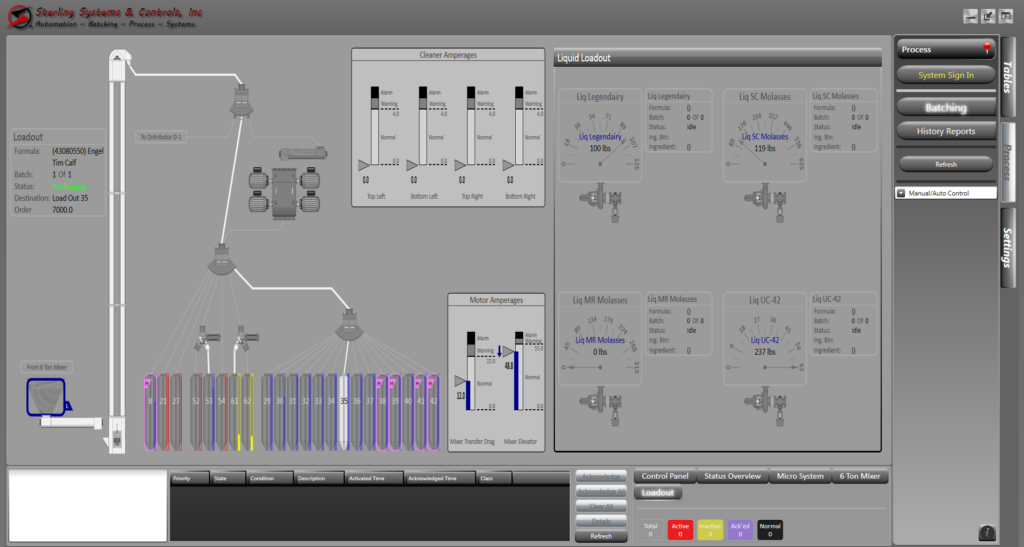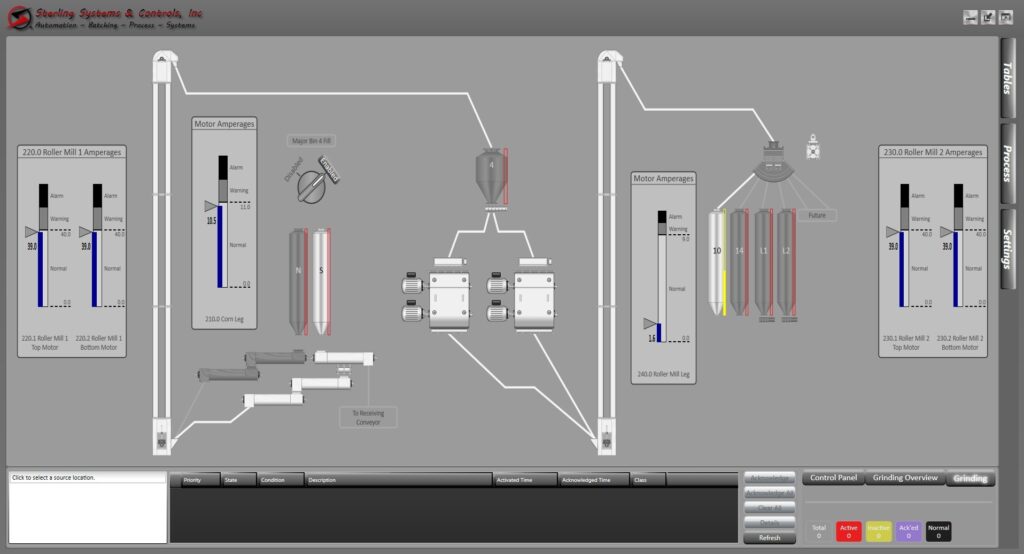Revolutionizing Feed Mill Operations with Advanced Automation
There are multiple feed mill processes that animal feed manufacturers can automate to improve efficiency and productivity. Feed mill automation might include hardware for mechanizing batching systems and grinding, as well as software for optimizing load-outs and supporting the traceability of deliveries. Regardless of the feed mill process, automation can make operations more efficient and enhance the safety of those working in the feed mill. Automation can also grow profits by optimizing productivity, though feed producers must adopt a more open approach to technology and its use in animal feed production. Careful consideration should go into deciding on which feed mill processes to automate first or whether to take an all-at-once approach.
Transforming Feed Mill Processing with Automation
Enhancing the efficiency and productivity of feed production is crucial for supporting livestock farming and ensuring a stable food supply over the coming decades. To address this challenge, feed mill automation has become increasingly important. By integrating advanced software with traditional hardware, automation improves feed production processes, streamlines operations, and boosts productivity. These advancements also contribute to greater sustainability and reduce environmental impact.
Reasons to automate feed mill processes:
- Increased Efficiency: Automation speeds up production processes by eliminating manual handling, reducing waste and improving management of the feed ingredients..
- Improved Consistency of Feed: Automation can help ensure precise ingredient ratios and consistent mixing, which helps feed mill processes remain consistent to specific recipes or formulas, ensuring animals get the nutrition they need.
- Increased Productivity: Automation enables mills to produce more animal feed in less time.
- Scalability and Flexibility: Automation helps feed mills react to increases in demand and changes in feed mill processes that occur over time, with the help of process control systems using ERP (enterprise resources planning) software for collecting and evaluating data.
- Improvement in Traceability of Ingredients and Batches: Accurate records of ingredients and batches allow feed mill processors to better comply with regulatory requirements and industry standards.
- Sustainability: Feed mill automation systems lower energy costs by using components and machinery designed to make systems more energy efficient.
- Workplace Safety Improvements: By integrating sensors to monitor equipment, automation of more dangerous feed mill processes helps prevent worker injuries.
Feed mill automation is essential to meet the growing needs of livestock farmers and ranchers as they work to feed a growing global population. Whether producing beef, dairy, poultry, swine or other animal products, automation helps meet the growing demand in these agricultural sectors for quality animal feed. Strategies for automation involve various technologies that assist with controlling, managing, and monitoring feed mill processes.
Integrating Automation into Feed Mill Processes
Digital technology, in conjunction with connected sensors and other devices, has dramatically improved feed mill processes. Modern feed mill control systems can use technologies like cloud computing for data management and IIoT (Industrial Internet of Things) sensors for preventative maintenance. These technologies, in turn, help manage systems that formulate recipes with precision, reducing waste in feed mill processes. Sustainable practices and environmental responsibility have also become more important in animal-based agriculture. These days, feed mill operators must consider how their production processes impact the environment, mitigating them not only to avoid regulatory issues but also to make them better stewards of their land and other resources.
Benefits of Consistent Feed Formulation
Mill automation ensures batches are made accurately by precisely weighing ingredients and carefully tracking ingredient lots to make quality assurance easier. For example, automated feed mill processes might include batching systems that blend and deliver ingredients to produce animal feed. Mill automation also involves tailoring controls, equipment, and systems to each producer’s needs.
Equipment for automated feed mill processing systems might include:

- Ingredient batching systems (a.k.a. micro ingredient systems, microsystems, etc.) can automate the batching of various ingredients, such as grains and other ingredients, to ensure the nutrients that keep animals healthy and boost growth are properly included in the feed. Multiple-scale hoppers are essential to ensure batch capacity for the day as well as any anticipated increases in demand.
- Milling systems like grinders, hammermills, classifiers, etc., reduce various grains via an automated process that controls particle size reduction before the feed is pelletized. Automation also monitors operational safety and equipment health by continuously monitoring bearing temperatures, throughput velocity, and vibration in rotating equipment.
- Raw material storage and transfer systems, which include incoming grains and other ingredients, must be transferred from a truck or railcar to storage bins prior to processing. These storage bins contain various devices to track the receipt and transfer of material while also monitoring for efficiency and safety.
- Pellet mills are specialized machines that pelletize feed. Though not used for every type of animal feed, mill automation systems control the pelleting process, which requires monitoring to ensure efficiency and safety.
- Loadout systems must store various types of finished feed. The load-out function must be efficiently managed to ensure the correct type and amount of feed gets to a specific customer. These systems produce data that enables traceability and more efficient operations.
Feed mill automation systems transport and blend various ingredients to produce a batch, moving these to loadout bins, or else pelletized and then moved to loadout. These systems must work seamlessly with computerized controls and the software that supports the entire feed mill’s operation. While automating the proper weighing of constituent parts of formulas and recipes, automation in these feed mill processes also allows for automatic recording of ingredient usage and inventory reordering/resupply when they run low. Manufacturers often automate feed mill processes to support quality control, such as keeping track of bin assignments, ingredient locations, and lot numbers.
Decreasing the Chance of Human Error
Removing human workers from direct involvement in a feed mill processing system reduces labor costs and the chance of human error. This also allows personnel to focus on more complex tasks for which humans are better suited or which are less easily automated. Feed mill automation reduces accidents, with most modern control systems able to automatically shut the system down when sensors detect specific abnormalities. Automated feed mill processing solutions should also track the ingredients or products at a certain station, such as material levels in bins and silos. This simple automated function can, for example, negate the need for a worker to manually check how much material remains inside a bin, silo, or other storage area. This also increases employee safety as manual bin level checks may require climbing bins and silos, which require safety equipment and can be hazardous.
Feed mill automation helps decrease the need for human workers:
- Shifting personnel from the production floor to other, less dangerous tasks by transferring controls to computerized access points where someone can monitor and manage all feed mill processes.
- Reducing the chance of work-related injuries resulting from accidents where personnel are in direct contact with machinery.
- Production can be more easily scheduled through planning software that integrates production with operational data, allowing feed mill processes to be precisely timed through the seamless exchange of information between disparate systems.
- Removing the need for operators to manage continuous feed mill processes, such as extrusion and pelleting functions.
- Eliminating job functions in automated feed mill processes, such as load-out, where RFID (radio frequency identification) and other technologies ensure that loads are placed on the correct truck with minimal involvement from the driver or feed mill employees.
- Decreasing the need for manual work and, in turn, lowering labor expenses.
- Assessing inventory through feed mill automation software platforms. The manual inventory management of the ingredients and products that go into animal feed becomes unnecessary. Inventories can be recorded and adjusted in real-time.
- Altering labor-intensive feed mill processes, such as adding feed to bins, to make them automated improves safety and reduces the likelihood of human error.
Safety is increased throughout a feed mill when workers no longer need to do potentially hazardous tasks or work in dangerous environments. Processes are all controlled via software, which causes equipment to shut down when something goes wrong or restart automatically when certain parameters are met.
Sterling Systems Feed Mill Automation

Sterling Systems & Controls Inc. understands the nuances of the feed industry, which relies more on custom controls than some other industries. For more than a half-century, we have provided feed mill automation to help improve the efficiency of feed mill processes and systems while producing the highest-quality animal feed. Mill automation control systems can be used to regulate just a specific machine or to control the manufacturing processes and supply of feed for multiple types of livestock.
Some of the automated solutions we provide include:
- Pellet mill control system: This control system is tailored to enable operations personnel to monitor the pellet mill and specify required setpoints using the provided operator interface and PLC controller. The pellet mill controls will monitor and provide analysis of mash temperature, the steam valve, and overall mill production in real time.
- Load-out feed mill automation system: This load-out system can custom fill a truck with multiple orders. It can determine which load should go into each compartment in a truck’s trailer to ensure quick, efficient, and accurate product loading for delivery.
- Ingredient batching system: Weighing ingredients precisely for each batch, our batching control system can include micro, minor, and major weightments from a variety of storage bin sizes, bulk totes, or bulk bags. Ingredient batching can be automatic and provide the capacity, accuracy, and record-keeping needed. The batching controls can allow for virtually unlimited recipes/formulas using your required accuracy and capacity. Integrating batching ingredient usage and tracking data with your ERP or other system can be done.
- Hand prompt batching controller: A semi-automatic system for batching, this controller is sometimes just referred to as a batching controller or batching station that provides a cost-effective means to improve your current manual batching processes, curtailing product waste and operator errors; its scalability and flexibility ensure a better return on investment, with software for the controller automatically weighing ingredients that are then verified by the system.

- Grinding feed mill automation system: This system controls the grinding process for particle size reduction, such as for incoming raw grains, providing processed grains for feed production on a timetable with no or very little human intervention necessary for this function.
- Feed mill automation receiving and transfer system: This system can simplify receiving and transfer operations for raw ingredient materials to augment throughput and cost-efficiency. It is essential for proper feed mill operations.
- Automated feed mill control system: These control systems can control any feed mill process or entire facility. They use Sterling’s custom Windows-based software for feed mill automation and an Allen-Bradley PLCs. They can incorporate server and cloud-based technologies and integrate with other software systems, including ERP, for data management and transfer.
Feed mill automation from Sterling Systems & Controls comes with customized software solutions and standardized control and automation hardware, using PCs running our Windows-based feed mill automation software tailored to each customer’s needs and Allen-Bradley PLCs.
Next Step
With over 50 years of expertise in custom engineering process control & automation systems, material weighing, ingredient batching, liquid handling, and other bulk material handling and complete process solutions, Sterling Systems & Controls proudly has the experience to assist you in revolutionizing your feed mill processes or your entire facility. Contact us today to discuss how our knowledge and experience can align with your goals and how you can continue your journey toward manufacturing excellence! We can provide testimonials for our complete process systems in various agriculture and industries, including animal feed, animal nutrition, baking and food processing, pet food manufacturing, thermoplastic compounding, and more.